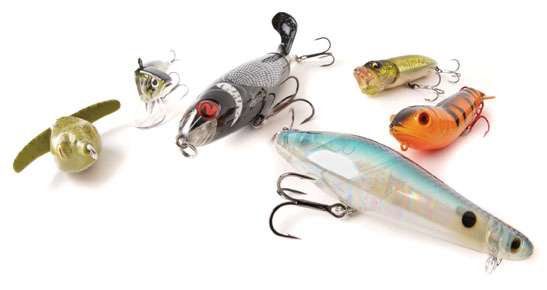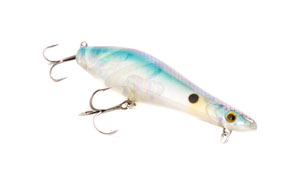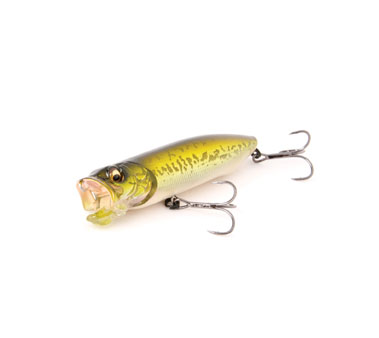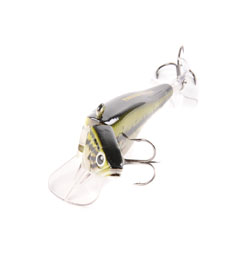
You’d have to forgive Jon Bondy if it appeared as if he’d gone a little bit crazy during practice for an Elite Series event on Falcon Lake in 2008. While the other pros flipped and Carolina rigged, maybe threw a spinnerbait here and there, it’s almost certain that no one else was throwing the bait on the end of his line — a beastly 8-inch contraption from Musky Buster Lures called the Top Walker.
There are no muskies in Falcon
Maybe the long drive had gotten to him. After all, in terms of changes in latitude, there are few points in the continental United States farther away from his Windsor, Ontario, home than Zapata, Texas. Then again, Bondy, who guides for both muskies and smallmouth when he’s not fishing tournaments, catches tons of big bass every year while targeting muskies. In fact, he said it’s a rare muskie fishing day when he doesn’t latch on to a 4-pound smallmouth that’s decided to crash his oversize baits.
While he eventually caught his tournament fish on soft plastics, the Top Walker gave away their locations during the practice period. The front half of the bait is a bulbous section of wood that rotates like a buzzbait, while the back half is a traditional bucktail. It weighs 1 1/2 ounces with dual 3/0 trebles — probably too big to specifically target bass on most lakes, and that’s why it appealed to him.
“It’s totally off the wall,” he says. “Something they’ve never seen before, and I’m sure they think it’s some type of terrestrial animal.”
Indeed, it’s a good lesson for anglers everywhere to learn. When bass have become conditioned to every standard popper, walker and prop bait on the tackle store shelf, but prime topwater conditions prevail, sometimes it pays to go with something they’ve likely never seen before.
John Bondy: Frantic Fred
 Bondy’s Falcon experience caused him to connect the dots even further about applying muskie lures to tournament bass situations. Indeed, while educated fish are acutely aware of just about every popular bait, the ability to show them something new intrigued him. Since then he’s had some killer days with the Frantic Fred from Sledgehammer Lure Company. While it comes in a 9-inch size, there’s also a lesser-known 4-inch version that is just right for tournament applications.
Bondy’s Falcon experience caused him to connect the dots even further about applying muskie lures to tournament bass situations. Indeed, while educated fish are acutely aware of just about every popular bait, the ability to show them something new intrigued him. Since then he’s had some killer days with the Frantic Fred from Sledgehammer Lure Company. While it comes in a 9-inch size, there’s also a lesser-known 4-inch version that is just right for tournament applications.
The Frantic Fred can be walked like a Heddon Zara Spook or a Lucky Craft Sammy, but unlike most walking baits that have little or no action on a straight retrieve, it also has a distinctly appealing action when reeled across the top. On a steady retrieve, the curved body shape “causes it to just kind of snake across the top,” Bondy says. “And when you walk the dog, it does a little bit of spitting, too. It’s just a different look.”
His guiding business typically puts him on world-class smallmouth waters, even when he’s focused in on muskies. He’s realized that when confronted with the snaking action of the Frantic Fred “the smallmouth go absolutely nuts, and when you catch one, it’s usually at least 3 or 4 pounds.”
He’s also pleased that it’s American-made, which is typical of most of the muskie genre. He fishes it on the same 6-foot, 6-inch to 7-foot medium-heavy baitcasting rod he would use to heave other bass-size walking topwaters. The lighter, shad-oriented color schemes will work from coast to coast, although in the North he dotes on a natural perch pattern.
Ish Monroe: River2Sea Whopper Plopper
 When Ish Monroe needs a big, noisy bait with an oversized profile, he turns to the River2Sea Whopper Plopper, a 5-inch jointed hard bait that kicks up a fuss. The front section looks much like any other walking bait, but the tail end of this 1 3/8-ounce behemoth rotates like a buzzbait blade and sprays water. There are also glass beads inside to make additional noise.
When Ish Monroe needs a big, noisy bait with an oversized profile, he turns to the River2Sea Whopper Plopper, a 5-inch jointed hard bait that kicks up a fuss. The front section looks much like any other walking bait, but the tail end of this 1 3/8-ounce behemoth rotates like a buzzbait blade and sprays water. There are also glass beads inside to make additional noise.
“Since I got it last fall, I’ve been throwing it over grass and around docks,” he says. “In slick, calm conditions, you can wind it like a buzzbait, but in windy conditions you can really rip it. You have to let the fish tell you. I was on Clear Lake one day winding it, and I never had
a bite. Then I started ripping, and I caught a bunch of big fish.”
He uses it when searching for beds, too, and that’s how he’s caught some of his biggest fish this spring. Typically, he starts with a mostly black loon pattern that provides a big profile under all conditions.
“You can catch lots of 2- and 3-pounders on it, but when you need a big bite, 7-plus, that’s when you should pull it out,” Monroe explains. “The strikes are absolutely explosive.”
He throws it on a 7-foot, 7-inch Daiwa Ballistic composite rod, paired with a 6.3:1 Daiwa Zillion reel, spooled with 50-pound Samurai Braid. “I use braid on all of my topwaters except a Devil’s Horse,” he says. “You can make longer casts, get a better hookup ratio and you don’t break fish off.”
Randy Howell: Molix Proteus
 When conditions are calm and bass want an aggressive topwater with a small profile, Randy Howell turns to the 3 1/2-inch Proteus from Italian lure manufacturer Molix. Unlike many other walking baits, which are roughly the same diameter from nose to tail, the Proteus has a narrow nose before widening out substantially just beyond the midsection. Combined with an internal tungsten weight system that moves but doesn’t float freely, in addition to walking, “this bait hops,” Howell says.
When conditions are calm and bass want an aggressive topwater with a small profile, Randy Howell turns to the 3 1/2-inch Proteus from Italian lure manufacturer Molix. Unlike many other walking baits, which are roughly the same diameter from nose to tail, the Proteus has a narrow nose before widening out substantially just beyond the midsection. Combined with an internal tungsten weight system that moves but doesn’t float freely, in addition to walking, “this bait hops,” Howell says.
As a result of its architecture, at rest this lure sits low in the water, to the point that just its nose is sticking out above the surface.
“I fish it pretty much with a fast retrieve, then stop it suddenly, then get fast again,” Howell says. “A lot of times, when you stop it, that’s when they’ll blast it.”
He used it successfully this year in an Elite Series tournament on Okeechobee and expects that it will be particularly deadly on lakes with blueback herring.
His favorite colors are aurora ocean and silver bait, and he throws the lure on a 7-foot, 2-inch Daiwa Steez rod paired with a Daiwa Type-R Zillion reel spooled with 55-pound-test Samurai Braid.
Aaron Martens: Megabass XPod
 The XPod can’t decide whether it wants to be a popper or a walk-the-dog lure, so Megabass decided to make it both. It comes in two sizes — a 4 1/4-inch, 3/4-ounce version and a 3 1/2-inch, 1/2-ounce model — but the trick isn’t in the profile of the bait. Instead, it’s all about the built-in adjustable lip, which can be placed in any one of seven different positions, taking it anywhere from a gaping-mouthed popper to a true walking bait.
The XPod can’t decide whether it wants to be a popper or a walk-the-dog lure, so Megabass decided to make it both. It comes in two sizes — a 4 1/4-inch, 3/4-ounce version and a 3 1/2-inch, 1/2-ounce model — but the trick isn’t in the profile of the bait. Instead, it’s all about the built-in adjustable lip, which can be placed in any one of seven different positions, taking it anywhere from a gaping-mouthed popper to a true walking bait.
Aaron Martens says his favorite position is “three clicks down,” which allows the lure to walk and chug, but he’ll make it either more or less aggressive depending on how the fish react. If they want it walked fast, there’s an application that’ll get that done, or it can be changed to chug and spit.
Most importantly, it’s a lure that allows for different fish attitudes. “You can go from quiet to obnoxious real fast,” he said. He can adjust on the fly without retying, even from cast to cast, to take advantage of the amount of chop or shade on the water.
Martens fishes the XPod and the XPod Jr. on a Megabass F5-72XRC baitcasting rod, a 7-foot, 2-inch medium action rod rated for 1/4- to 1-ounce lures. By combining a main line of 20-pound Sunline braid with a short leader of 16-pound-test Sunline Shooter, he can maintain the lure’s action, but he can also set the hooks at the end of a long cast. He likes a variety of colors for the lure, but if forced to choose one for all conditions, it would be GG bass.
Brent Broderick: Think Tank Triggerfish
 Brent “Brody” Broderick employs the Triggerfish, a jointed, shad-shaped topwater with a propeller blade on the rear, when he wants a lure that’s “steerable” through thick cover. “I was a skeptic at first, but the way it lays on its side makes it look just like a dying baitfish.
Brent “Brody” Broderick employs the Triggerfish, a jointed, shad-shaped topwater with a propeller blade on the rear, when he wants a lure that’s “steerable” through thick cover. “I was a skeptic at first, but the way it lays on its side makes it look just like a dying baitfish.
“I throw it in places where other guys would throw a frog,” he continues. “It’s particularly good under overhanging trees where you can’t see it.” In fact, he’ll often spend most of a retrieve with the bait out of sight, waiting for a telltale splash to give away a strike. He’ll also use it around willow bushes, stickups and laydown logs — any piece of thick cover that most other anglers would flip.
“It has a pivoting head, so you can dial yourself in on directing it where to go,” Broderick adds. He’ll start with a steady retrieve, but when he wants it to shift direction, he’ll stop it momentarily, forcing the head to pivot. When he resumes his slow, steady retrieve, the lure will track in the direction that the head has turned.
Broderick fishes the lure on a Dobyns Rods topwater stick, usually with 30-pound Vicious Braid, which maximizes action and floats, thereby keeping the lure from diving. Furthermore, it allows him to winch bass out of gnarly cover. He’s done best on the silver shad and baby bass patterns, although he switches to perch when confronted with bedding smallmouth.
Clark Reehm: Deps Basirisky
 It may get generically categorized as a frog, but the Basirisky is named after the Basilisk lizard. With its wobbling side-to-side action, it also
It may get generically categorized as a frog, but the Basirisky is named after the Basilisk lizard. With its wobbling side-to-side action, it also
resembles a baby duck teetering across the surface. Clark Reehm thinks the hollow body and its perpendicular legs replicate the action of an old-school favorite: “It has an action like a totally weedless Jitterbug,” he says. “It’s especially great around milfoil, and unlike most other frogs that you have to work, this one is pretty much a do-nothing situation. You just reel it steadily, and it creates the action on its own.”
Most importantly, he said it’s a great change of pace when conditions are prime for a hollow-bodied frog, but the bass have seen hundreds of them.
As a result of its flush-mounted single hook, the Basirisky comes through vegetation cleanly, but it also has a remarkably good hookup percentage. It’s tail-weighted, and the body compresses upon impact to allow the hook to penetrate.
The Basirisky is available in 60mm and 70mm sizes, which weigh a 1/2 ounce and 3/4 ounce, respectively. Reehm keeps his color choices simple, as he does with all of his typical frog fishing — “white, black and some sort of natural shade are all you need,” he says. He fishes it on a Dobyns model 736 rod (7-feet, 3-inches; 6-power) and Seaguar Kanzen braided line. “It rolls and walks better on lighter braid, but I’ll never go less than 40,” he says. “If you’re around extremely heavy cover and big fish, you can go as high as 80.”
Outside the box
Many anglers believe there’s no more exciting way to catch bass than on top, but there is one way to improve the experience — catch a big one on a bait that nobody else on the lake has in their possession. Dial in that pattern and have the day of a lifetime while others beat the water to a froth and scratch their heads.
Originally published March 2013. To view more of Bassmaster Magazine, click here.





